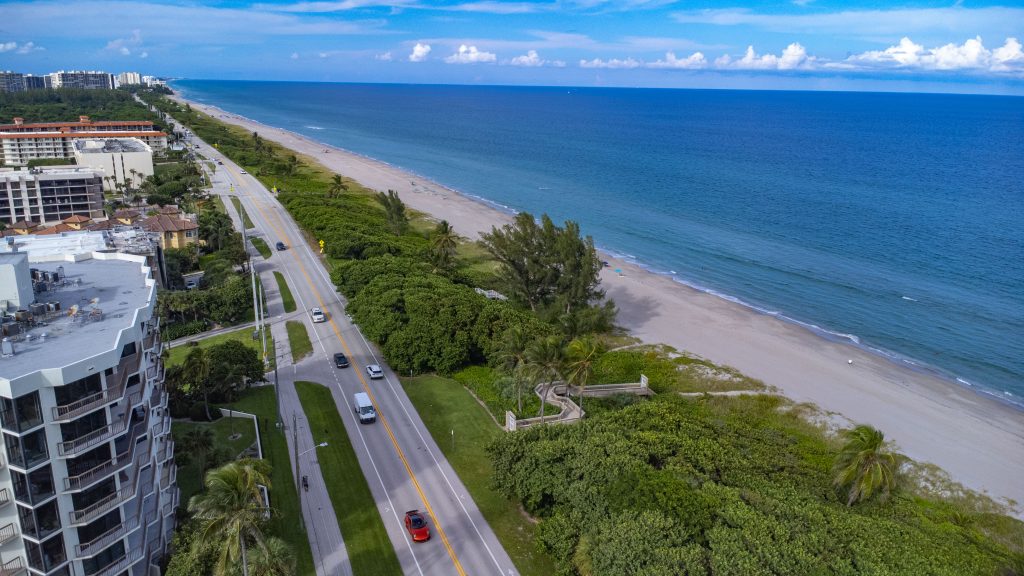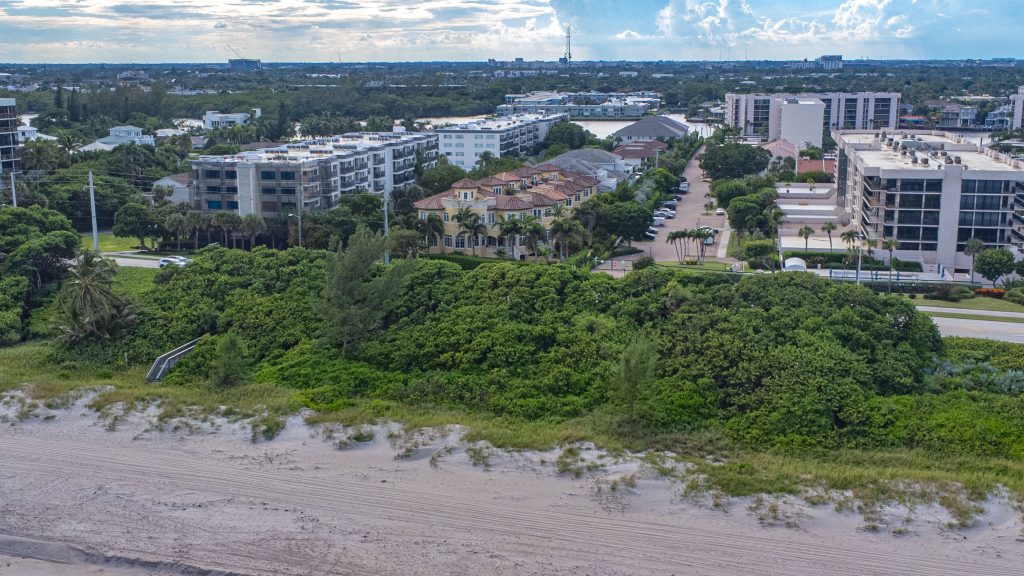A years-long saga over the construction of a home on the oceanfront in Boca Raton has finally come to an end, with the property being approved despite considerable opposition.
By the end of a hearing that was stretched over three hours, the city council approved a scaled-down iteration of a proposal to build a residential home east of the Coastal Construction Control Line at 2600 N. Ocean Boulevard (A1A), citing the fact that a judge has already ruled that the property owner’s rights to develop the parcel remain intact.

The area of the property at 2600 N. Ocean Boulevard (A1A), Boca Raton, FL, Oct. 2024. (Photo: Boca Daily News)
Objectors to the construction testified that they believed the construction of the 2,776 square foot, single-family home would set a precedent that could lead to further development along the ocean, and would negatively impact sea turtles and other marine life, as well as the dune line. Professionals testified on behalf of the property owner, however, that extraordinary measures – beyond virtually any taken in the entire state – to minimize impacts to the environment led to approval from the state Department of Environmental Protection for the development to move forward. Further, they said, the property owner has volunteered to remove all invasive and exotic plants from the dune line and replace them with native plants, representing the only section of beachfront in Boca Raton that will be free of non-native flora.
Ultimately, however, the wrangling over the project’s environmental impact were overcome by legal realities: litigation resulted in an affirmation of property rights to the parcel’s private owner, and a second denial of the application by the city council would inevitably lead to more litigation that would likely result with a court-ordered approval of the development and an order mandating taxpayers reimburse the owner’s legal fees.
Modifications from the original plan, introduced in 2019, reduce the building’s footprint from 3,080 square feet to 2,776 square feet; eliminates more than half of the building area, from 14,270 square feet to 6,931 square feet; reduces the height from 49 feet to 38 feet; and significantly drops impervious coverage from 6,644 square feet to 2,776 square feet.

The area of the property at 2600 N. Ocean Boulevard (A1A), Boca Raton, FL, Oct. 2024. (Photo: Boca Daily News)
Despite a smaller size and a pledge from the owner to relocate a ground-level pool to the roof, and build a driveway in an elevated position over the dune line so it would not be disturbed, some neighbors and environmental advocates called on the council to deny the application anyway.
“The development certainly will endanger sea turtles,” said George Salinger, president of the neighboring Yacht and Racquet Club of Boca Raton development. “The loss of the nesting area caused by the construction would force females to nest closer to the beach areas, or subject some of the nests to wash out in the waves.”
Another resident, Michael Laszlow, said the property owner should not be granted a variance to build east of the coastal control line because they “put themselves in this position” simply by purchasing it. That, Laszlow believed, should preclude the right of the owner to seek a variance that is conditioned on a hardship created by the city – the CCCL ordinance – after the lot was established.
“They own a lot on which construction is forbidden,” he said. “Had they never purchased this lot, the special and unique condition disappears, since they never would have owned this property.”
Matthew Pintchik, who also resides in the Yacht and Racquet Club community, said he moved to Boca Raton to allow his disabled child to access a “quiet” beach.
“Simply put, approving this variance would be a tremendous loss for our family and goes against the essence of this beach, which we believe should be quiet and undeveloped,” he told council members. “We’re setting a precedent that will destroy the peace and quiet that residents and visitors have come to expect.”

The area of the property at 2600 N. Ocean Boulevard (A1A), Boca Raton, FL, Oct. 2024. (Photo: Boca Daily News)
Robert Sweetapple, the attorney representing the property owner, cast doubt on the motivation behind members of the nearby homeowners’ association objecting to the development.
“I understand, they don’t want to see a house,” he said. “They want to go to their private beach that their communities own on either side, and they want to enjoy their private beach, and they don’t want to see what my client does with his private property.”
Sweetapple also noted that the Yacht and Racquet Club voluntarily gave up its own development rights on the oceanfront in exchange for permission to build more units across the street.
Given the approvals the project has received from the DEP, as well as a recommendation for city approval by the municipal staff, Sweetapple said environmental issues have already been settled. Likewise, he said, the court has already upheld the right of the property owner to develop the lot even though they did not own it in the 1940s when it was subdivided.
“This property came with the right to seek a variance,” he said. “That’s part of its bundle of rights – when you purchase it, that doesn’t mean you give up your rights, it means you can exercise your rights. There is a severe misunderstanding on what the law requires.”
Ultimately, the council voted 4-1 to approve the matter, with most members citing the legal realities of the case and the fact that the property owner redesigned the proposal to be more environmentally friendly.
“Things happened that no one expected to happen 100 years ago,” said Councilman Marc Wigder. “The property was platted, there are many residential owners, and half the beach is developed with condos. Many of them are eastward of the Coastal Construction Line.”
Other council members said the city had decades to purchase the property – much like those which make up the bulk of the city’s oceanfront parks – but never did so.
“This whole conversation, for years, has been unpleasant,” said Mayor Scott Singer. “My hand is, I feel, forced by several things – one, where a court is likely to go … litigation will continue, and perhaps the number of square feet could be whittled down – one foot, 100 feet, 1,000 feet – but we’re going to keep litigating and litigating and litigating, and we’re going to keep incurring expenses on both sides.”
Singer said staff recommendations was a powerful factor in swaying his vote, combined with the court proceedings, and the property owner’s efforts to scale back the project and take measures to mitigate environmental impacts.
“It’s not a matter of weighing what you feel like doing,” he said, noting the council was not acting as a legislative body, but a quasi-judicial body under state law. “There are private property rights involved, there are expenses to the city, and I have to be mindful of all that.”
The application was approved 4-1, with Councilman Andy Thomson casting the lone dissenting vote.

Follow Us on Facebook

Police, Fire & Courts
Boca Cops Nab Shoplifter, Linked to High-End Bike Theft at Publix

Police, Fire & Courts
Apple Store Altercation Leads to Boca Raton Man’s Arrest









